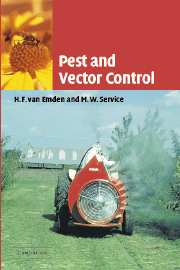Book contents
- Frontmatter
- Contents
- Preface
- 1 Man and insects
- 2 The causes of pest and vectored disease outbreaks
- 3 Insecticides and their formulation
- 4 Application of insecticides
- 5 Problems with insecticides
- 6 Environmental/cultural control
- 7 Biological control
- 8 Insect pathogens
- 9 Genetic control
- 10 Pheromones
- 11 Plant and host resistance
- 12 Other control measures and related topics
- 13 Pest and vector management
- Appendix of names of some chemicals and microbials used as pesticides
- References
- Index
8 - Insect pathogens
Published online by Cambridge University Press: 03 December 2009
- Frontmatter
- Contents
- Preface
- 1 Man and insects
- 2 The causes of pest and vectored disease outbreaks
- 3 Insecticides and their formulation
- 4 Application of insecticides
- 5 Problems with insecticides
- 6 Environmental/cultural control
- 7 Biological control
- 8 Insect pathogens
- 9 Genetic control
- 10 Pheromones
- 11 Plant and host resistance
- 12 Other control measures and related topics
- 13 Pest and vector management
- Appendix of names of some chemicals and microbials used as pesticides
- References
- Index
Summary
Introduction
Microbial pesticides are an increasingly important area of biological control. The current Biopesticides Manual (Copping, 2001) lists 44 commercially available products used for the control of insect pests. Such ‘germ warfare against insects’ has quite a long history. The Russians carried out the first experiments as early as 1884, and a commercial preparation of a fungus (Beauveria) was available in Paris in 1891. Like insecticides, pathogens can be stored for a period, marketed in drums, diluted with water and passed through a spraying machine.
Pathogens are, of course, biological control agents. However, they have several important differences from animal natural enemies, particularly much shorter generation times and vast production of propagules; also that they can be sprayed from traditional sprayers. They do not seek out their prey, but rely on chance contact. Moreover, in some cases an insect toxin produced by the pathogen is used rather than the living organism, and then there is no multiplication or recycling of the pathogen. For all these reasons, it seems appropriate to deal with pathogens in a separate chapter. Although a great variety of pathogens, viruses, bacteria, protozoa and fungi have been recorded from medical and veterinary pests, very few have actually shown promise as control agents. There seem to be several reasons for this. It would prove logistically difficult, if not impossible, to spray the numerous and scattered resting sites of dipterous vectors, such as mosquitoes and simuliid black flies, with pathogens; consequently control would have to be aimed at their aquatic larvae (but see p. 183 on how entomopathogenic fungi can kill ticks).
- Type
- Chapter
- Information
- Pest and Vector Control , pp. 177 - 189Publisher: Cambridge University PressPrint publication year: 2004



